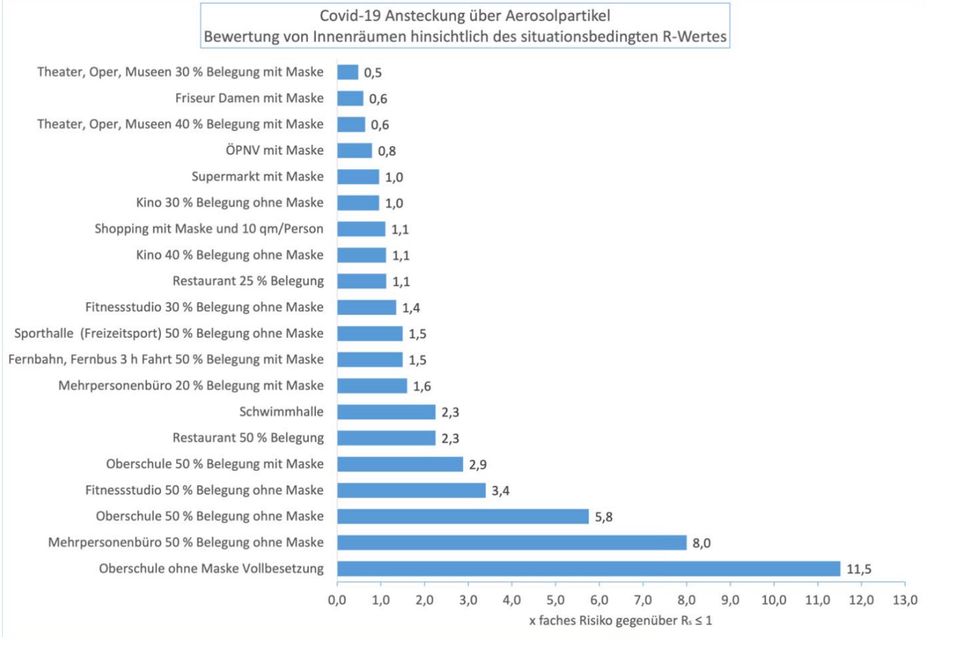Corona current
Cinema or supermarket? In which rooms are we most likely to get infected?
© Mr.Music / Shutterstock
In a study, researchers compared the indoor spaces in which we are most likely to be infected with corona. The results are surprising.
While many parents are still waiting for schools and daycare centers to reopen, others are hoping that shopping centers or entertainment venues such as the cinema will open quickly. But in which indoor spaces – and under which circumstances – is the risk of being infected with COVID-19 actually highest? Martin Kriegel from the Hermann Rietschel Institute at the Technical University of Berlin and his colleague Anne Hartmann investigated this question mirror reported. The experts have calculated how high the risk of infection is via the so-called aerosols in different rooms and have just published the results in a preprint. This means that the results have not yet been checked by independent experts.
Corona: This is how important distance and breathing masks remain
According to the study, keeping a distance from one another and continuing to wear breathing masks is and will remain the most important factor in avoiding infection. Whether you are infected by the aerosols or not depends primarily on the inhaled dose. This in turn depends on various factors, such as the length of time spent in a room and the respective breathing activity. Loud singing and panting, for example, increase aerosol emissions – this was already known before the study. Thanks to the investigation, we now also know that medical mouth and nose protection can reduce aerosol emissions and the amount of these small particles inhaled by around 50 percent.
An example of the influence masks can have according to the study: In a fully occupied high school without masks, the risk of infection is 23 times higher than in a theater that is only 30 percent occupied and in which all spectators are wearing masks. If the number of schoolchildren were to be halved and a mask requirement was introduced, the risk of infection would drop from 11.5 times to 2.9 times.
The basics of calculation
In general, the experts have assumed for their calculations that people adhere to the distance and mask rules and that there are ventilation concepts for the respective interior spaces that are adhered to. So-called typical use values were assumed for the respective length of stay in the rooms. This means that it is assumed, for example, that you spend an hour in the supermarket and eight hours at work. A so-called R value (Rs) was calculated from this data. This is the number of infected people when an infected person is present in a room at the same time. If R is less than or equal to 1, the number of new infections decreases.
In order to be able to compare the different interiors with one another, the researchers compared different outbreaks and created a calculation model from them. "On this basis, we were then able to derive in a simplified manner how much air is required per person and per hour of stay so that this situation-related R value is less than one," says Kriegel. "And then you get numbers that you can compare with each other." It was important to the experts to be able to compare typical interior situations – In the following graphic you can get an idea of how high the risk of infection is in which rooms:

© Hermann Rietschel Institute | TU Berlin
The experts don't want to make recommendations for politics, as Kriegel emphasizes: "It's not just about the specific situation. In the theater, for example, you somehow have to get to your seat, to the cloakroom, to the toilet – that's all other situations with a different risk. " Nevertheless, the calculations show that consistently implemented hygiene concepts could enable various facilities to be reopened in the future.
Mutations not taken into account
The new mutations of the coronavirus, for example the British variant with the designation B1.1.7, are not taken into account in the calculation. With this variant, one suspects that the R value could be 30 to 50 percent higher. This would increase the risk of infection, but the respective relationships between the interior situations would not change.
Swell: spiegel.de, TU Berlin

